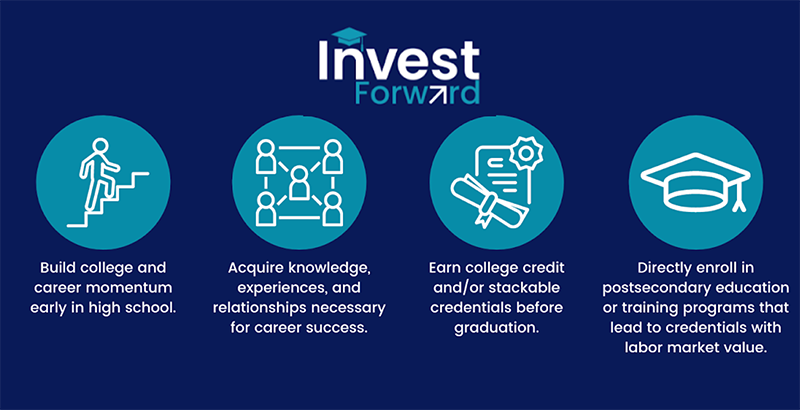Gandal: American Rescue Plan Is a Chance to Boost Economic Opportunity and Mobility for Students. New Guide Spells Out 4 Things Districts Can Do

Get stories like these delivered straight to your inbox. Sign up for The 74 Newsletter
For millions of students, access to higher education is the best shot at a ticket to the middle class. Unfortunately, the path to economic mobility is already riddled with potholes for far too many young people. Every year, as many as 1 million students graduate from high school and do not move directly into higher education and training — and with the pandemic turning those potholes into sinkholes, that number has dramatically decreased even further. Students of color and those from low-income families have suffered the worst impact. Without immediate action, the consequences will be felt by generations to come.
Fortunately, with the passage of the American Rescue Plan, the federal government has made one of the most dramatic attempts of our lifetimes to give communities the tools to rebuild. With $123 billion flowing to K-12 education, it is an opportunity to not only address gaps created by the pandemic, but to invest in long-term solutions that can serve as a down payment on economic opportunity and mobility for students.
However, pathways to postsecondary education and training are not showing up as a major investment priority in states’ and districts’ rescue fund spending plans. Just 12 percent of initial district spending priorities mention designated funding for supporting students’ postsecondary readiness. Given the critical importance of education beyond high school, this is a troubling sign.
A targeted focus on increasing students’ preparation for and access to postsecondary education and training can make the difference between a community that is an engine of economic mobility and one that is stagnant. To capitalize on the wide latitude they have on the spending of relief funds, school systems will need to look beyond the guidance issued by the U.S. Department of Education for ideas.
To provide inspiration and, more importantly, a clear set of shovel-ready investment strategies, my organization is collaborating with other national and regional partners to identify strategies that work in closing postsecondary readiness and transition gaps. The initiative is called “Invest Forward,” and it includes the following priorities for K-12 school systems’ rescue fund spending plans:
Build college and career momentum early in high school
Students who successfully complete core courses by the end of ninth grade are significantly more likely to enroll in college immediately after high school. Yet schools too often wait until junior or senior year to engage students in college and career planning, and low-income students and students of color are much less likely to have access to quality advising and counseling than their more privileged peers. As schools bounce back from the pandemic, it’s an opportune time to ensure that early and integrated college and career counseling is an expectation for every student, not an enrichment for some. Delaware, for example, is planning to use a portion of its rescue funds to expand advising so students understand the connections between postsecondary education and careers, develop a high school plan, and set college and career goals.
Equip all students with the knowledge, experiences and relationships necessary for career success
When it comes to building a foundation for long-term career success, students need connections, skills and experiences in addition to strong academics. Districts should use rescue plan funds to expand peer advising, hands-on learning experiences and other strategies for building career pathways and boosting students’ social and network capital. Chicago Public Schools, for example, is investing $5 million to expand work-based learning opportunities throughout the city, and Tennessee is awarding $30 million in grants for districts to foster partnerships and prepare high schoolers for careers in their communities.
Increase the number of students earning college credit and credentials before graduation
Students are significantly more likely to access and succeed in higher education if they can earn college credit before high school graduation. Rescue plan funds provide the perfect opportunity for districts to make advanced coursework and dual enrollment — which can be prohibitively expensive — available to every student, and to provide the support and guidance needed to help them succeed. Milwaukee Public Schools, for instance, plans to expand dual enrollment access by supporting students’ transportation, materials and tuition costs, and Hawaii is investing $6 million of its its stimulus resources in a summer learning program, which includes access to dual-enrollment courses at the University of Hawaii.
Increase direct enrollment in postsecondary education or training programs that lead to a credential of value
High school graduation is not the end goal, so schools’ and districts’ responsibilities for students shouldn’t end there. To counter the growing gaps in college enrollment brought on by the pandemic, districts should invest rescue plan funds in keeping students on the postsecondary path and facilitating a seamless transition between high school and higher education. Texas and Indiana have used stimulus funds to launch statewide summer bridge programs; Texas has already seen a return on its investment, with more students enrolling and succeeding in higher education. Arizona plans to invest over $2 million to ensure students complete the Free Application for Federal Student Aid and receive advising support through the summer transition. In New York, Buffalo Public Schools is investing in a postsecondary persistence tracking database to analyze trends in higher education, so it can more efficiently and effectively provide support to high school students.
Ultimately, I hope that schools and districts see the investment of their rescue plan funds as a long-term play. Though some of this money is undeniably needed to fill immediate pandemic-induced gaps, this is an opportunity for significant long-term investment that we are unlikely to see again in our lifetimes. Schools must make sure to spend these resources with the end goal in mind: equitable access to higher education and a better shot at economic mobility for millions of students across the country.
Matt Gandal is president and CEO of Education Strategy Group.
Get stories like these delivered straight to your inbox. Sign up for The 74 Newsletter

;)
